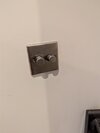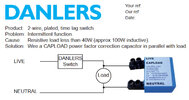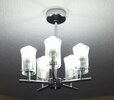A LED bulb can vary as to how it is made, the very basic bulb has a capacitor to control current, then a full wave rectifier to make it DC, and then another this time electrolyte capacitor to smooth the supply, a small leak resistor to let it switch off reasonably fast and stop any induced current in the AC supply keeping LED's on dim, and then the LED's, this works, but does not give the best lumen per watt, and makes them very voltage dependent and takes up room in the bulb, so the two bulbs shown here, both G9 bulbs, the capacitor in the larger bulb is nearly the size of the smaller bulb.
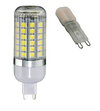
and typically G9 bulbs have covers, they were required with halogen bulbs, so it makes the whole lamp look very different with the larger bulb. The smaller bulb would stay on dim, and have a shimmer, the larger bulb worked A1.
The electronic switch I was using had a
compatibility list and even using the bulb listed there was a problem. Bulbs often do not use the method described and use discreet components
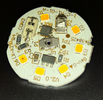
giving better control, shown is a E14 candle bulb, still needs the smoothing capacitor
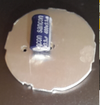
and it is pot luck as to the capacitor size. Some lamps are far more complex inside
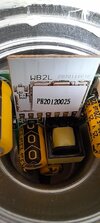
it is not a simple design like the tungsten, and even in the days of tungsten some times the coil of the filament would end up forming a tuned circuit with the dimmer switch, causing both flicker and radio interference, today the chance of the two devices forming a tuned circuit is even greater.
So simple method is use dimmer unit and bulb from same manufacturer. Although Varilight dimmer switches do seem to have a good name, personally I use smart bulbs as these will also allow change of colour temperature as well, so have a better ambiance, and unless supper cheap, keep away from integral lamps, so one can change the bulb.
When we went through the CFL stage, dimmer switches would not work, so the method adopted is to switch on more or less lamps, often split 1/3 and 2/3 so there three levels of lighting, I have done this with my landing light fitted a smart relay in the lamp, so can select centre, outer or both.
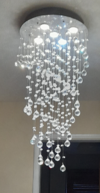
It does need some thought, want it so it looks as if designed that not all lamps are lit, living room the display cabinet and uplighters supplements the main light, must admit in the main down lights don't work very well, the light is absorbed by the carpet rather than reflected off the ceiling, but the dangly bits do spread the light.
A easy way with GU10 down lights is replace just some with smart bulbs, then you can turn selected lights down, or change colour, but main thing keep away from integral lamps.



